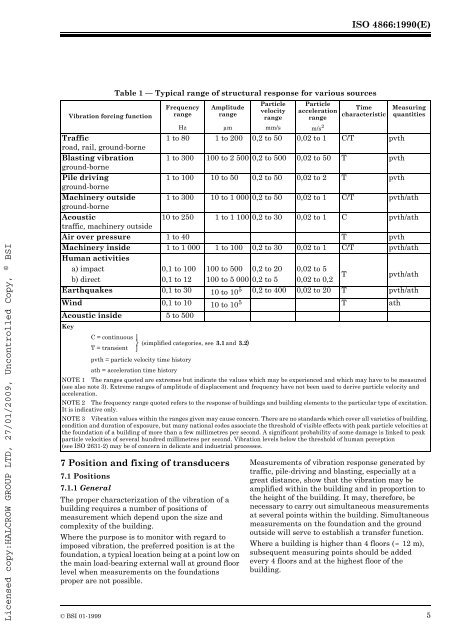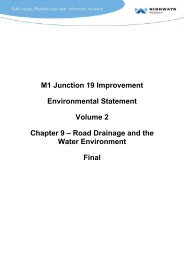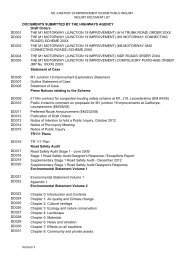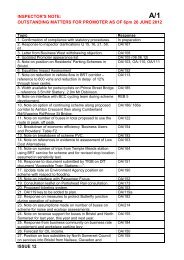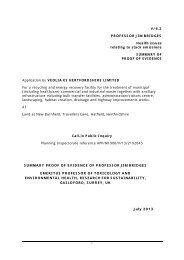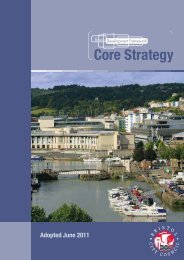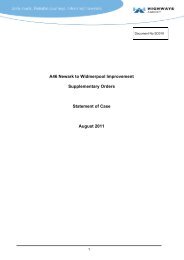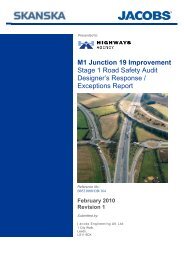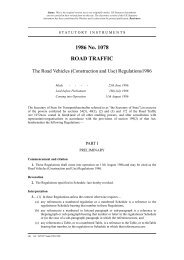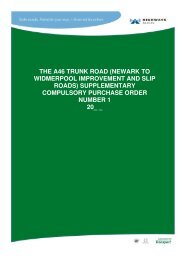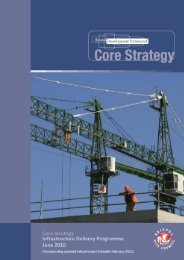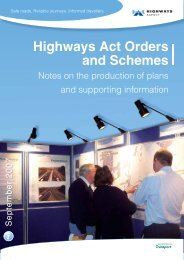Evaluation and Measurement for Vibration in Buildings Part 1, BSI ...
Evaluation and Measurement for Vibration in Buildings Part 1, BSI ...
Evaluation and Measurement for Vibration in Buildings Part 1, BSI ...
Create successful ePaper yourself
Turn your PDF publications into a flip-book with our unique Google optimized e-Paper software.
ISO 4866:1990(E)<br />
Licensed copy:HALCROW GROUP LTD, 27/01/2009, Uncontrolled Copy, © <strong>BSI</strong><br />
<strong>Vibration</strong> <strong>for</strong>c<strong>in</strong>g function<br />
Table 1 — Typical range of structural response <strong>for</strong> various sources<br />
7 Position <strong>and</strong> fix<strong>in</strong>g of transducers<br />
7.1 Positions<br />
7.1.1 General<br />
Frequency<br />
range<br />
Amplitude<br />
range<br />
The proper characterization of the vibration of a<br />
build<strong>in</strong>g requires a number of positions of<br />
measurement which depend upon the size <strong>and</strong><br />
complexity of the build<strong>in</strong>g.<br />
Where the purpose is to monitor with regard to<br />
imposed vibration, the preferred position is at the<br />
foundation, a typical location be<strong>in</strong>g at a po<strong>in</strong>t low on<br />
the ma<strong>in</strong> load-bear<strong>in</strong>g external wall at ground floor<br />
level when measurements on the foundations<br />
proper are not possible.<br />
<strong>Part</strong>icle<br />
velocity<br />
range<br />
<strong>Part</strong>icle<br />
acceleration<br />
range<br />
Hz µm mm/s m/s 2<br />
Time<br />
characteristic<br />
Measur<strong>in</strong>g<br />
quantities<br />
Traffic<br />
1 to 80 1 to 200 0,2 to 50 0,02 to 1 C/T pvth<br />
road, rail, ground-borne<br />
Blast<strong>in</strong>g vibration 1 to 300 100 to 2500 0,2 to 500 0,02 to 50 T pvth<br />
ground-borne<br />
Pile driv<strong>in</strong>g<br />
1 to 100 10 to 50 0,2 to 50 0,02 to 2 T pvth<br />
ground-borne<br />
Mach<strong>in</strong>ery outside 1 to 300 10 to 1000 0,2 to 50 0,02 to 1 C/T pvth/ath<br />
ground-borne<br />
Acoustic<br />
10 to 250 1 to 1100 0,2 to 30 0,02 to 1 C pvth/ath<br />
traffic, mach<strong>in</strong>ery outside<br />
Air over pressure 1 to 40 T pvth<br />
Mach<strong>in</strong>ery <strong>in</strong>side 1 to 1000 1 to 100 0,2 to 30 0,02 to 1 C/T pvth/ath<br />
Human activities<br />
a) impact 0,1 to 100 100 to 500 0,2 to 20 0,02 to 5<br />
b) direct 0,1 to 12 100 to 5000 0,2 to 5 0,02 to 0,2<br />
T<br />
pvth/ath<br />
Earthquakes 0,1 to 30 10 to 10 5 0,2 to 400 0,02 to 20 T pvth/ath<br />
W<strong>in</strong>d 0,1 to 10 10 to 10 5 T ath<br />
Acoustic <strong>in</strong>side 5 to 500<br />
Key<br />
C = cont<strong>in</strong>uous<br />
T = transient<br />
⎬ ⎫<br />
⎭<br />
pvth = particle velocity time history<br />
ath = acceleration time history<br />
(simplified categories, see 3.1 <strong>and</strong> 3.2)<br />
NOTE 1 The ranges quoted are extremes but <strong>in</strong>dicate the values which may be experienced <strong>and</strong> which may have to be measured<br />
(see also note 3). Extreme ranges of amplitude of displacement <strong>and</strong> frequency have not been used to derive particle velocity <strong>and</strong><br />
acceleration.<br />
NOTE 2 The frequency range quoted refers to the response of build<strong>in</strong>gs <strong>and</strong> build<strong>in</strong>g elements to the particular type of excitation.<br />
It is <strong>in</strong>dicative only.<br />
NOTE 3 <strong>Vibration</strong> values with<strong>in</strong> the ranges given may cause concern. There are no st<strong>and</strong>ards which cover all varieties of build<strong>in</strong>g,<br />
condition <strong>and</strong> duration of exposure, but many national codes associate the threshold of visible effects with peak particle velocities at<br />
the foundation of a build<strong>in</strong>g of more than a few millimetres per second. A significant probability of some damage is l<strong>in</strong>ked to peak<br />
particle velocities of several hundred millimetres per second. <strong>Vibration</strong> levels below the threshold of human perception<br />
(see ISO 2631-2) may be of concern <strong>in</strong> delicate <strong>and</strong> <strong>in</strong>dustrial processes.<br />
<strong>Measurement</strong>s of vibration response generated by<br />
traffic, pile-driv<strong>in</strong>g <strong>and</strong> blast<strong>in</strong>g, especially at a<br />
great distance, show that the vibration may be<br />
amplified with<strong>in</strong> the build<strong>in</strong>g <strong>and</strong> <strong>in</strong> proportion to<br />
the height of the build<strong>in</strong>g. It may, there<strong>for</strong>e, be<br />
necessary to carry out simultaneous measurements<br />
at several po<strong>in</strong>ts with<strong>in</strong> the build<strong>in</strong>g. Simultaneous<br />
measurements on the foundation <strong>and</strong> the ground<br />
outside will serve to establish a transfer function.<br />
Where a build<strong>in</strong>g is higher than 4 floors ( ≈ 12 m),<br />
subsequent measur<strong>in</strong>g po<strong>in</strong>ts should be added<br />
every 4floors <strong>and</strong> at the highest floor of the<br />
build<strong>in</strong>g.<br />
© <strong>BSI</strong> 01-1999 5


